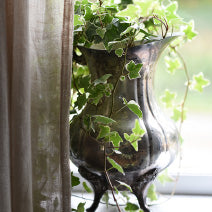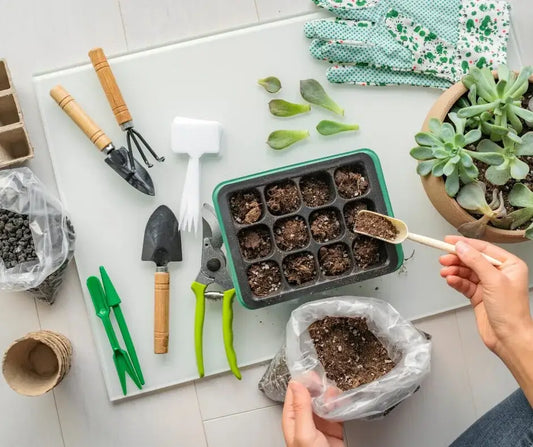 Autumn sort of sneaks up on you, doesn’t it? One week you’re dragging hoses outside in a heatwave to water all the plants on your porch. A few weeks later, you’re quickly running all those plants inside to protect them from predicted frosts. So sometimes, the process gets a little rushed. In fact, it’s frighteningly close to a fire drill, in reverse. So this year, how about organizing the fall ritual and making the most of your resources. The result will be many months of sparkling splendor on your windowsills. And in a few months, those houseplants will be lifesavers.
Autumn sort of sneaks up on you, doesn’t it? One week you’re dragging hoses outside in a heatwave to water all the plants on your porch. A few weeks later, you’re quickly running all those plants inside to protect them from predicted frosts. So sometimes, the process gets a little rushed. In fact, it’s frighteningly close to a fire drill, in reverse. So this year, how about organizing the fall ritual and making the most of your resources. The result will be many months of sparkling splendor on your windowsills. And in a few months, those houseplants will be lifesavers.
Making the Cut
What should come in from the cold? Feel free to expand the definition of houseplants! Although supermarkets and big box stores might profile the same old typical litany of foliage plants, you can expand on that roster and create your own concept for plants you want to invite indoors. Got a coleus that you’ve learned to love? Bring it inside. Especially dwarf varieties. Yes, coleus might require a stern pruning, but it’s worth a try. Is there an ultra-handsome ivy that’s been winding itself around the edges of your garden? Scoop some up and tuck it into a container. Love a fern or dusty miller? Get out that trowel and dig some up. Geraniums make great houseplants and blossom up a storm in midwinter if given sufficient light. Big happy bunches of colorful flowers will get you through winter. Certain plants won’t make the leap from outside to indoors. Most annuals such as most impatiens, snapdragons, salvias, cosmos, flowering tobacco, cleome, bachelor’s buttons, zinnias, and any plant that demands full, bright sun will not love life indoors. So kiss them goodbye and plan to order seeds or purchase plants next year. That said, you might find some unexpected roommates, such as cupheas and celosias. Several herbs—like silver and golden thymes—make great houseplants.
Got a coleus that you’ve learned to love? Bring it inside. Especially dwarf varieties. Yes, coleus might require a stern pruning, but it’s worth a try. Is there an ultra-handsome ivy that’s been winding itself around the edges of your garden? Scoop some up and tuck it into a container. Love a fern or dusty miller? Get out that trowel and dig some up. Geraniums make great houseplants and blossom up a storm in midwinter if given sufficient light. Big happy bunches of colorful flowers will get you through winter. Certain plants won’t make the leap from outside to indoors. Most annuals such as most impatiens, snapdragons, salvias, cosmos, flowering tobacco, cleome, bachelor’s buttons, zinnias, and any plant that demands full, bright sun will not love life indoors. So kiss them goodbye and plan to order seeds or purchase plants next year. That said, you might find some unexpected roommates, such as cupheas and celosias. Several herbs—like silver and golden thymes—make great houseplants. 
The Adoption Process
Preparing a plant for the move indoors is a snap. But a few careful steps now can spell the difference between success and disappointment. If you are digging a plant from a garden bed, shake off the garden soil and then match your new green roommate with a container that fits the root system without cramming it or making it swim in too much excess space. Next, moisten some Coast of Maine Bar Harbor Blend Potting Soil and repot your new adoptee. Be sure to firm the soil around the root system. Check all plants thoroughly for pests while in the process. Love a plant in a mixed container? No need to part ways if that plant can make the leap onto your windowsill. However, too many plants in one container can wrestle for sunbeams in a windowsill. Instead, break them apart. If you go with a mixed container, it’s safest to select shade-loving plants such as sedges with moss. Or pot plants separately. Again, use your Coast of Maine Bar Harbor Blend Potting Soil for repotting.
It Takes all Types
What if you’ve fallen for a succulent that you’ve learned to love outdoors? Maybe you’d like a more intimate relationship with a sedum, crassula, hens & chicks, aloe or kalanchoe. Be sure to match any succulent with a container that offers excellent drainage. In most cases, you want to keep the roots contained to a tight pot rather than being overly generous with root room. For your potting mix, opt for Coast of Maine’s Mount Desert Island Blend Organic Cactus & Succulent Mix. And find a spot that basks in the sunbeams of your home. A south-facing window will be ideal.Being Creative
 Think about design when welcoming plants into your home. You can be so creative. Consider linking into the style of your interior—whether it’s contemporary, traditional, or historic. Let the container steer the mood. Depending on your style, you can adapt all sorts of dishes and pots to become planters adding to the atmosphere. If your containers don’t have drainage, succulents might not work. But other plants, such as ivies, ferns, and mosses will do just fine in pots without drainage if you put in a base of pea stone pebbles and horticultural charcoal in the container to keep the soil sweet. Or if possible, drill drainage holes. The goal is to make plants part of your lifestyle. Don’t think of autumn as the end of the growing season. Instead, welcome fall as the start of a new relationship that will make everyone green with envy.
Think about design when welcoming plants into your home. You can be so creative. Consider linking into the style of your interior—whether it’s contemporary, traditional, or historic. Let the container steer the mood. Depending on your style, you can adapt all sorts of dishes and pots to become planters adding to the atmosphere. If your containers don’t have drainage, succulents might not work. But other plants, such as ivies, ferns, and mosses will do just fine in pots without drainage if you put in a base of pea stone pebbles and horticultural charcoal in the container to keep the soil sweet. Or if possible, drill drainage holes. The goal is to make plants part of your lifestyle. Don’t think of autumn as the end of the growing season. Instead, welcome fall as the start of a new relationship that will make everyone green with envy.Written by award winning author, Tovah Martin. Photos also taken by Tovah Martin. Find her books and more information on her website: tovahmartin.com.













